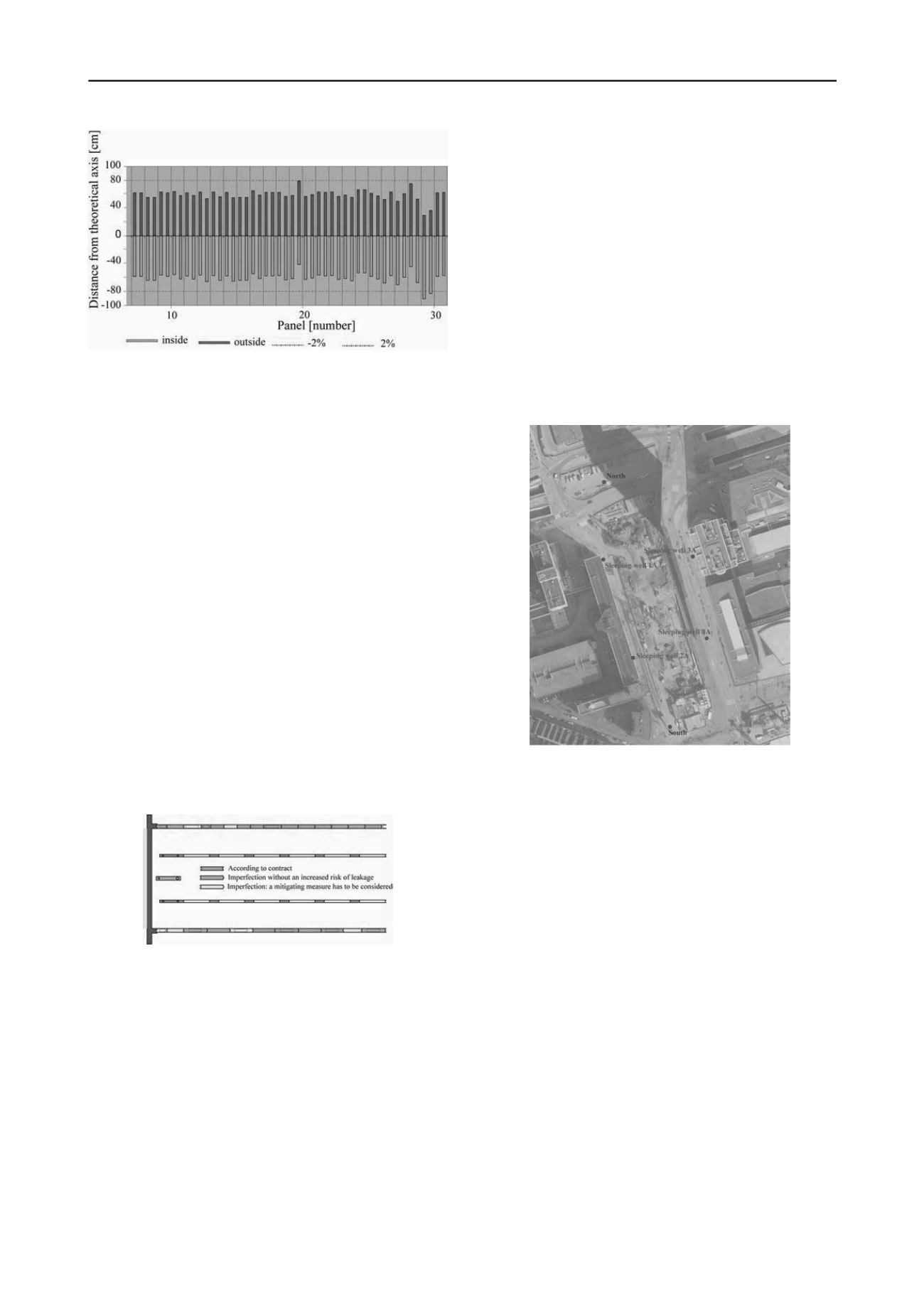
1878
Proceedings of the 18t
h
International Conference on Soil Mechanics and Geotechnical Engineering, Paris 2013
Figure 5. Relative position of the panels at 40 m depth. Dark represents
the outside of the diaphragm wall; light the inside. The dotted red lines
represent the 2% deviation of the verticality.
6.4 Non-standard measurement techniques
Reference is made to Doornenbal et al. (2011) and Spruit et al.
(2011) for more information on the experiments using non-
standard measurement techniques to detect imperfections in
diaphragm walls, which appeared to be quite successful.
6.5 Increased risk of leakage
Combined interpretation of Figures 3 to 5 reveals areas where
an increased risk of leakage has to be anticipated for, as
compared to normal conditions. Following aspects have been
evaluated using the outcome of the interpretation of the as-built
records:
- a missing/damaged water-stop;
- no cleaning of the concrete surface;
- the elapsed time between refreshing of the bentonite and
the commencement of concreting greater than 24 hours;
- encountered problems during the stop end removal works;
- concrete characteristics;
- wall thickness reduction > 0.20 m (Figure 4),
- reduced overlap < 0.80 m (Figure 5).
An overview of locations with an increased risk of leakage
along the excavation circumference has been generated as
shown in Figure 6.
Figure 6. Increased risk of leakage.
Subsequently, a number of mitigating measures has been
defined for each individual panel as to compensate the increased
risk. It appeared from the overall risk analysis that careful
positioning of four ‘sleeping’ wells around the excavation
would provide sufficient means for acting in case of leakage at
any of the identified weak spots as shown in Figure 7.
Additionally, for a number of panels it has been recommended
to call for an intensified inspection and repair program (when
necessary) during the excavation works.
7 CONCLUSIONS
The realized diaphragm wall panels were in general of sufficient
quality. A number of hot spots along the circumference of the
building pit with a increased risk of leakage were identified.
The risk profile related to leakage was considered to be at an
acceptable level if a number of mitigating measures were
executed. These measures were supplementary to the required
measures in the contract.
A pumping test to check the water tightness of the
diaphragm walls is very valuable in case the subsoil conditions
are similar to those in Rotterdam.
Supervision of the construction process appeared to be an
important mitigating measure, in combination with the
registration of the execution data of the diaphragm wall, and the
subsequent analysis of these data.
The extensive acquisition of data as such is not new for the
construction of diaphragm walls, but the systematic analysis of
the data, as performed for this project, has not been noticed so
far. It is recommended to do so for all future projects.
The positioning of ‘sleeping’ wells can be considered as a
major mitigating measure, and is a lesson learned from the
construction of the (leaking) diaphragm wall at metro station
CS.
Figure 7. Positioning of the four ‘sleeping’ wells east and west of the
building pit. Additional wells may be installed at the north and south
side in case of a calamity in the northern or southern wall.
ACKNOWLEDGEMENTS
The work on this subject of former colleagues Edwin Dekker
and Rens Servais is gratefully acknowledged. Records of the
execution of the diaphragm walls have been provided by the
contractor Besix BV. Colleague Arie van de Heerik collected
most of the records, and Ton de Keiser prepared the illustrations
in this paper.
REFERENCES
Doornenbal, P., Spruit, R., and Hopman, V. 2011. High resolution
monitoring of temperature in diaphragm wall concrete
. Proc.
FMGM2011, Berlin.
EN 1538 2010.
Execution of special geotechnical work – Diaphragm
walls.
Hannink, G. and Thumann, V.M. 2007. Existing structures govern
building methods near Rotterdam Central Station
. Geotechniek,
special edition, September, 2007, 26-29.
Spruit, R., Hopman, V., van Tol, A.F., and Broere, W. 2011. Detection
of Imperfections in Diaphragm Walls, field test results.
Proc.
FMGM2011, Berlin.
Thumann, V.M., Hannink, G. and Doelder, B.R. de 2009. Ground
freezing and groundwater control at underground station CS in
Rotterdam.
Proc. 17
th
Int. Conf. On Soil Mech. and Geot. Eng.,
Alexandria.


